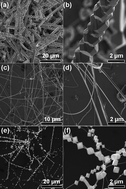Supersaturation-controlled synthesis of diverse In2O3 morphologies and their shape-dependent sensing performance†
Abstract
The precisely controlled synthesis of a specific morphology is proved to be highly effective for enhancing sensing performance of functional micro- and nano-materials. Thus, a comprehensive understanding of the effect of synthesis conditions on morphology evolution is of great importance. In this paper, by using In2O3 as an example, we demonstrate the great effect of supersaturation on the morphology evolution during the growth process. Under vapour-phase synthesis, by varying positions of product collection, the amount of the starting materials, and reaction temperatures, a continuous two-step route consisting of ammonolysis and re-oxidation processes was developed for the morphology evolution of several kinds of In2O3, including octahedron strings, nanowires, crystal chains, lollipop-like structures, and particles. The controlled supersaturation of the In2O3 vapour was eventually proved to be a decisive factor for the formation of various In2O3 morphologies. Furthermore, we evaluated the gas-sensing properties of the three kinds of one-pot synthesized In2O3, indicating a shape-dependent relationship with sensing performance. The present work not only offers a unique strategy to control supersaturation in vapour-phase synthesis, but also provides an opportunity to deeply understand the morphology-dependent sensing performance.


 Please wait while we load your content...
Please wait while we load your content...